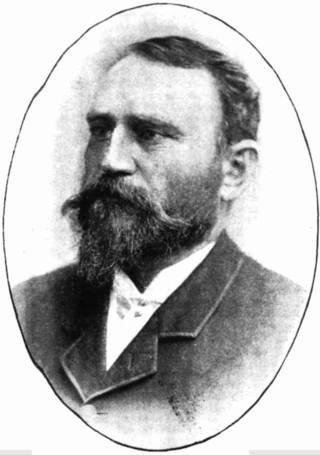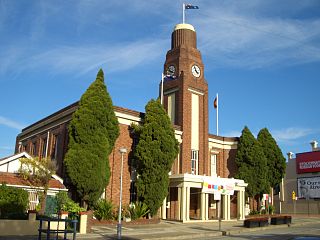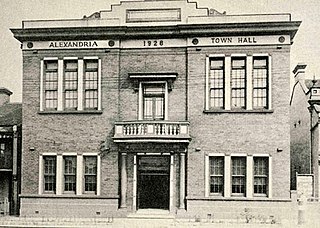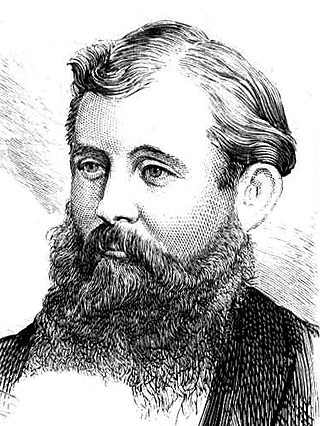Obed West (4 December 1807 - 24 August 1891) was an early resident of Sydney, Australia and a story-teller of its early days.
Contents

Obed West (4 December 1807 - 24 August 1891) was an early resident of Sydney, Australia and a story-teller of its early days.

Obed West was born in Pitt Street, Sydney, in a house on the eastern bank of the Tank Stream between what is now Martin Place and King Street. [1] He was the son of convict parents, Thomas West (1773-1858) and Mary Rugg. [2]
In 1810 West's father obtained Barcom Glen, a 75-acre (30 ha) property above Rushcutter's Bay, to construct and operate a water mill for milling flour [3] [4] and West lived there from that date until his death in 1891. In 1836, his father conveyed the property to him on condition that he not sell, alienate or dispose of any of it, except by leases not exceeding 19 years. [5] The land, at the edge of the inner Sydney suburb of Paddington, therefore remained largely undeveloped at least until 1910. [6] It was said that the property remained, at West's death, "an oasis of verdant green and spreading forest trees in a wilderness of terraced houses". [7] The family home at Barcom Glen was demolished in 1912. [8] [9]
In 1831, West married Jane Lindsey (1811-187) at St James’ Church, Sydney. [10]
West was a businessman and milled flour with his father's watermill - the first of its type for grinding flour in Sydney. He also bred cattle in the Camden district, and carried on a dairy business and grew fruit at Barcom Glen. [11]
It was said that he was an accomplished shooter and that "for years he was considered the best marksman in the colony". [11] In 1851, he received the first gold medal for a rifle shot in New South Wales - the medal, of "Bathurst gold" was for second place at a quarterly meeting of the Sydney Rifle Club. [12]
West rose to prominence as a source of reminiscences of the early days of Sydney, in 1882, initially in response to a series of articles in the Sydney Morning Herald under the title "Old and New Sydney". His contributions to the historiography of Sydney started with letters to the Editor of the Herald, the first two of which were over pen names: "A resident of the locality since 1810", [13] and "Patria". The third letter, which acknowledged authorship of the earlier two, bore his own name, [14] as did the next one. [15]
The Herald then published further contributions from West as part of the "Old and New Sydney" series with articles on George Street, [16] Pitt Street, [17] Sydney's harbour and ocean bays, [18] Chapel Row and the old Sydney Racecourse, [19] and Redfern and surrounding suburbs. [20]
The articles in the "Old and New Sydney" series, together with West's letters, were so popular that, in 1882–1883, they were collected and reprinted by the drapery firm of Edward Hordern and Sons for distribution to its customers. [21]
West quickly became an authority on early Sydney, as interest in the city's history increased in the lead up to the centenary of the settlement in 1888. Articles and letters subsequent to the "Old and New Sydney" series were on a variety of topics, including: the islands of Port Jackson; [22] the Illawarra district; [23] the Camden district; [24] Cowpastures; [25] Jack Kable the pugilist; [26] the old Sydney butter market and Central Police Office; [27] and wells and water pumps of early Sydney. [28] One of his last contributions was by way of an interview in the Daily Telegraph in 1888. [29] His writings and recollections were also relied on by The Aldine Centennial History of New South Wales. [30]
A descendant edited and published a collection of West's writing in 1988. [31]
West relied on oral traditions, so his recollections, while sometimes accurately recording popular misconceptions of the time, could be subject to correction, as was the case with his recollections on the origins of Govett's Leap. [32] [33]
Of particular interest are the writings that arise from West's contact with the local Aboriginal people, one of whom, Cruwee, apparently witnessed one of the early arrivals of the British in Botany Bay, saying the vessels were thought to be "floating islands". West, possibly influenced by the Aboriginal perspective, referred to Cruwee's description of "the monsters which had invaded their shores". [34]
West died at Barcom Glen and was buried at St Jude's Cemetery, Randwick. [35] He was survived by 13 of his 14 children. [36] It was said that, at his death, he had 113 living descendants. [37] One son, Thomas John West, was an Alderman of Paddington Council in 1893–1906, Mayor of Paddington in 1897-1899 and an Alderman of the Sydney Council, 1900–1906. [38] [39]
One obituary stated that West "saw the history of New South Wales through all its subsequent eventful periods until the present time. The early history of the Colony, indeed, was a subject in which he took considerable interest. He was not only intimately acquainted with its more prominent events, but a good memory furnished him with recollections of subjects which most men in these days of rapid development and continual changes invariably forget. The appearance of the city in its very early times, the laying out of the streets, the situation of the principal buildings, the rise and progress of its suburbs were almost as familiar to him as the names of his own immediate relatives. He was full of reminiscences of the past, and he seems to have clung to old memories with all the mental tenacity which a conservative disposition has for what, by sometimes a strange perversion of veracity, is called the good old times." [40]

Waverley Council is a Local government area in the eastern suburbs of Sydney, in the state of New South Wales, Australia. First incorporated on 16 June 1859 as the Municipality of Waverley, it is one of the oldest-surviving local government areas in New South Wales. Waverley is bounded by the Tasman Sea to the east, the Municipality of Woollahra to the north, and the City of Randwick in the south and west. The administrative centre of Waverley Council is located on Bondi Road in Bondi Junction in the Council Chambers on the corner of Waverley Park.
South Sydney was an electoral district for the Legislative Assembly in the Australian state of New South Wales from 1880 to 1894, covering the southern part of the current Sydney central business district, Haymarket, Surry Hills, Moore Park and Chippendale, bordered by George Street, Broadway, City Road, Cleveland Street, South Dowling Street, Dacey Avenue, the western edge of Centennial Park, Moore Park Road, South Dowling Street, Oxford Street and Liverpool Street. It elected four members simultaneously, with voters casting four votes and the first four candidates being elected. For the 1894 election, it was replaced by the single-member electorates of Sydney-Phillip, Sydney-Belmore, Sydney-Flinders and Sydney-Cook.

John Henry Want was an Australian barrister and politician, as well as the 19th Attorney-General of New South Wales.

The Municipality of Petersham was a local government area of Sydney, New South Wales, Australia. The small municipality was proclaimed as a borough in 1871 and was centred on the suburbs of Lewisham, Petersham and Stanmore. It was bounded by Parramatta Road in the north, Cardigan and Liberty Streets in the east, Stanmore and New Canterbury Roads in the south, and Old Canterbury Road in the west. The municipality was divided into three wards: South Kingston, Annadale and Sydenham, all the names of early farms. The boundaries remained fairly stable, with only minor changes on the east and western sides. The borough became a municipality in 1906. In 1949 under the Local Government (Areas) Act 1948, Petersham council was merged with the larger neighbouring Marrickville Council which was located immediately to the south.

The Municipality of Alexandria was a local government area of Sydney, New South Wales, Australia. Originally part of the municipalities of Redfern from 1859 and Waterloo from 1860, the Borough of Alexandria was proclaimed on 27 August 1868. With an area of 4.2 square kilometres, it included the modern suburbs of Alexandria, Beaconsfield and parts of Eveleigh, St Peters and Erskineville. After a minor boundary change with the Municipality of Erskineville in 1908, the council was amalgamated with the City of Sydney, along with most of its neighbours, with the passing of the Local Government (Areas) Act 1948, although the former council area was later transferred in 1968–1982 and 1989–2004 to the South Sydney councils.

Thomas Garrett was a member of the New South Wales Legislative Assembly, newspaper proprietor and land agent.

John Fitzgerald Burns was an Australian politician, member of the Parliament of New South Wales, Postmaster-General in the 1870s and Colonial Treasurer in the 1880s.

John Beveridge, JP was a New South Wales businessman, sportsman and local government politician, who served as an Alderman (1886–1891) and Mayor of Redfern (1891).

The 1891 New South Wales colonial election was held in the then colony of New South Wales between 17 June to 3 July 1891. This election was for all of the 141 seats in the New South Wales Legislative Assembly and it was conducted in 35 single-member constituencies, 20 2-member constituencies, 10 3-member constituencies and nine 4-member constituencies, all with a first past the post system. Part 1 of the Electoral Act of 1880 set the qualification for election on "every male subject of Her Majesty of the full age of twenty-one years and absolutely free being a natural born or naturalized subject". Seven seats were uncontested. The previous parliament of New South Wales was dissolved on 6 June 1891 by the Governor, The Earl of Jersey, on the advice of the Premier, Sir Henry Parkes.

(James) Peter Howe was an Australian politician and convict.

Walter Hussey Vivian was an Australian politician.
William Johnston Allen was an Irish-born Australian politician.

William Consett Proctor was an English-born Australian solicitor and politician.

Thomas Michael Williamson was an Australian politician.

Charles Gilbert Heydon was an Australian politician and judge.

Alexander Cecil Knox Mackenzie was an Australian cricketer. He played 48 first-class matches for New South Wales and Rest of Australia between seasons 1888/89 and 1906/07. In the Sydney grade competition he is most well known for having played for the Paddington and Waverley clubs.

The Municipality of Paddington was a local government area of Sydney, New South Wales, Australia. The municipality was proclaimed on 17 April 1860 and, with an area of 1.7 square kilometres, included the entire suburb of Paddington and parts of Edgecliff. The council was amalgamated with the City of Sydney to the east with the passing of the Local Government (Areas) Act 1948, although the former council area was transferred in 1968 to the Municipality of Woollahra, transferred to the City of South Sydney in 1989 and was then split in 2003 between the City of Sydney and the Municipality of Woollahra.
A by-election was held for the New South Wales Legislative Assembly electorate of Paddington on 12 January 1888 because William Trickett was appointed to the Legislative Council.
Australian Kerosene Oil Company or 'A.K.O' mined and processed oil shale to produce kerosene, paraffin wax and candles, lubricating oil and greases, and other petroleum-based products, in New South Wales Australia. It is particularly associated with the site of its mine and works, at Joadja. At times, it also had other mining operations, at Airly and near Katoomba, and a soap and candle factory at Camellia. The company used the brand name 'Southern Cross' for its kerosene products.